Daboo printing also known as Dabu printing is one of the traditional indigo dye printing techniques in India. While there are many printing techniques that have become popular globally, this one is certainly not one of them.
Consumers today love to wear new-age fabrics and designs that make them appear modern and urban. However, in this race of development and technological influences, we have somehow got disconnected from our roots. This post is all about the art of daboo print or dabu print that has managed to stay alive despite tough market competition.
Thanks to Pushpendra and Walk and Pedal Travel Tours for providing Spirit of Art tours that focus on this particular fabric art at Aavaran. We did this tour on the same day after we completed our bicycle tour in Udaipur. After the cycle tour, we took a break for a few hours. Sarah and I returned to our Airbnb homestay in Udaipur.
We took a bath and recharged the camera batteries. My body was still aching after the cycle tour but it was better after the bath. Also, Pushpendra was so kind to pick us up from our location and take us to the place where we can experience something we had never seen before.
The Origin of Dabu Printing
The concept of block printing originated in China, but gradually it had its influence in India. Rajasthan became the leading producer of block printed fabrics and dabu print flourished here. Also known as the mud resist printing, Daboo printing history dates back to 675 A.D. in India. The art is immensely popular and has its presence in the village of Akola in Chittorgarh.
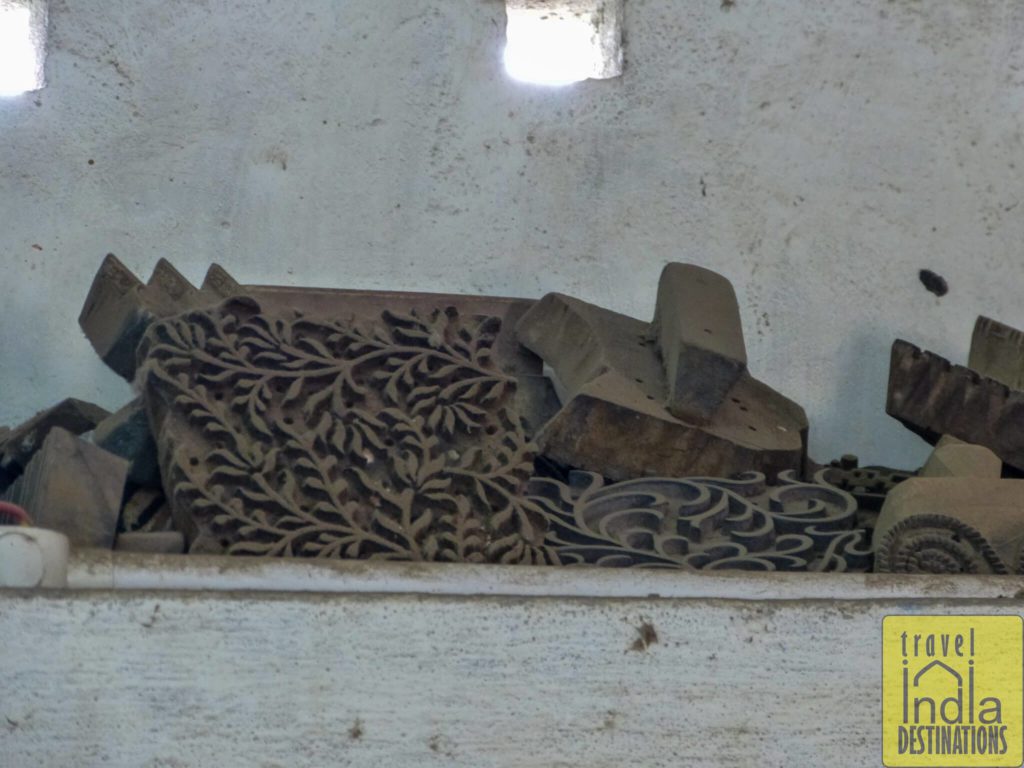
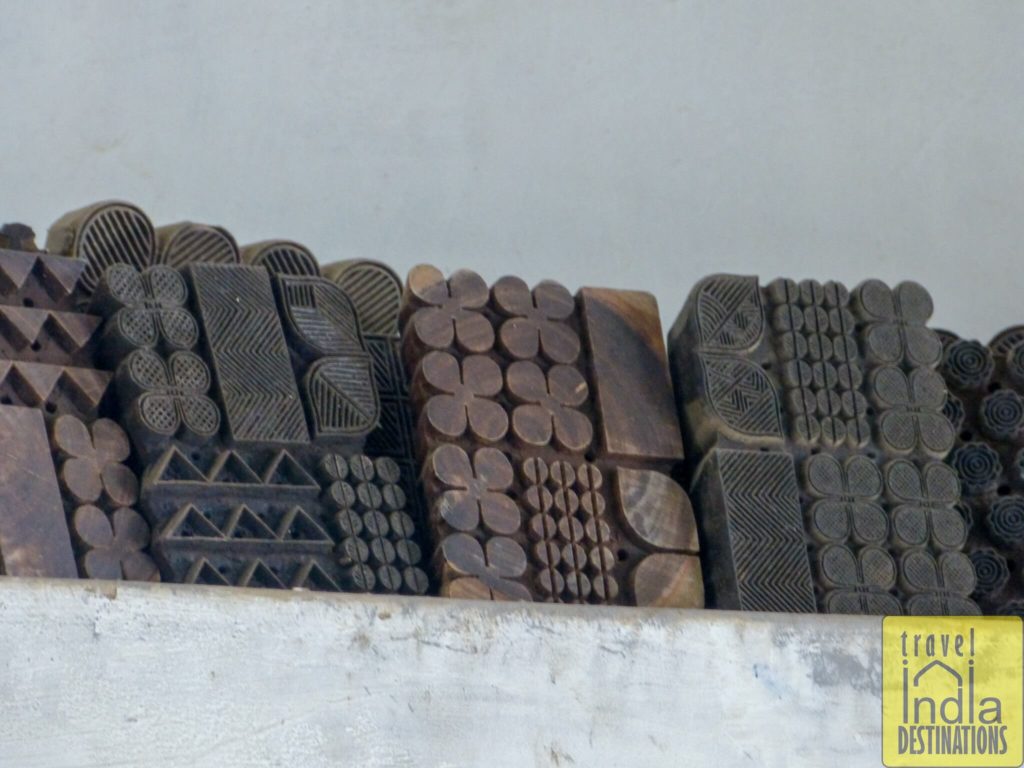
The internet says that the word ‘daboo’ originates from the Hindi word ‘Dabaana’ which means ‘to press’. However, I personally believe it comes from a Gujarati word ‘dabu’ which also means the same. The mud resist printing recipe is a guarded secret of the families that practice this art in Akola village in Chittorgarh.
Rajasthan is also popular for other block printing styles like Bagaru, Batik and Sanganeri. Daboo prints have similar designs to these other printing styles but have distinct look and procedure. Most of the dabu print designs take inspiration from nature.
Hence, you will see designs of plants, birds, flowers and fruits in ethnic motifs. The printing technique uses natural dyes made from fruits, flowers and vegetables and therefore it is environment-friendly.
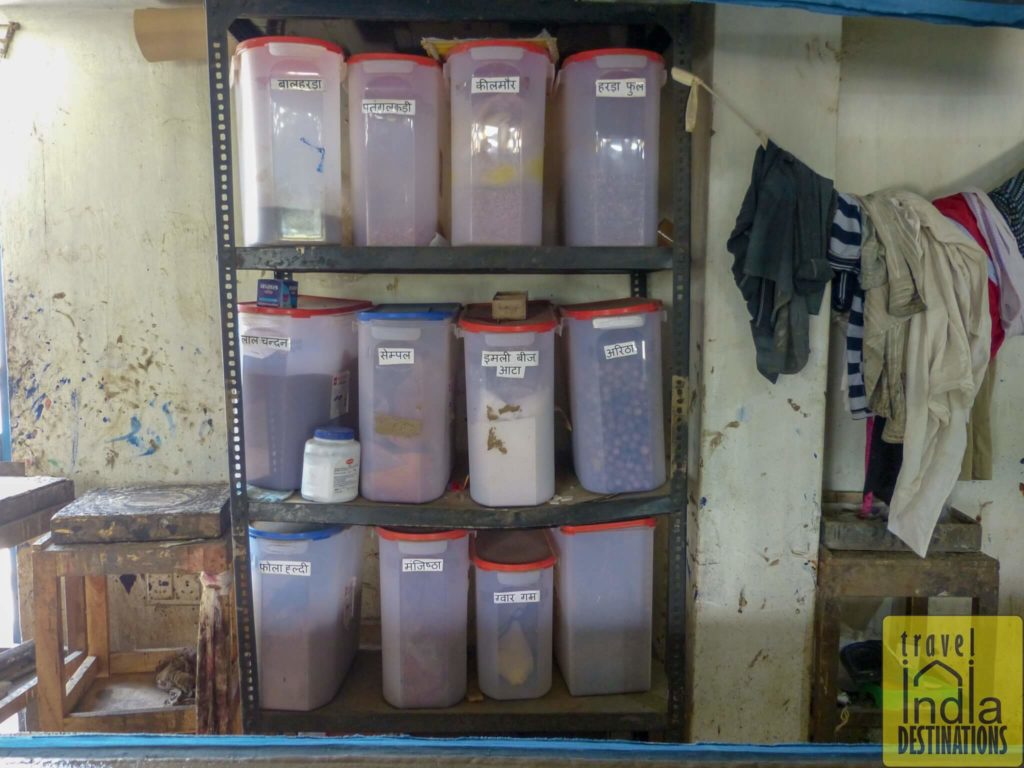
Daboo printing was immensely popular in Rajasthan and in other states of India. However, right before the Independence, machine fabric printing made its way in India. This was an easier, faster and affordable way to print fabrics.
On the other hand, Dabu printing is labour intensive and involves several stages of printing and dyeing. It became hard for daboo printing to match the competition. However, these families in the villages of Rajasthan have revived the art.
First Impressions of the Daboo Printing Facility:
On reaching the destination, we saw this huge space where blue and white sheets were drying in the sun. The white building looks very ordinary. It was surprising to see so many talented artists and minds working here.
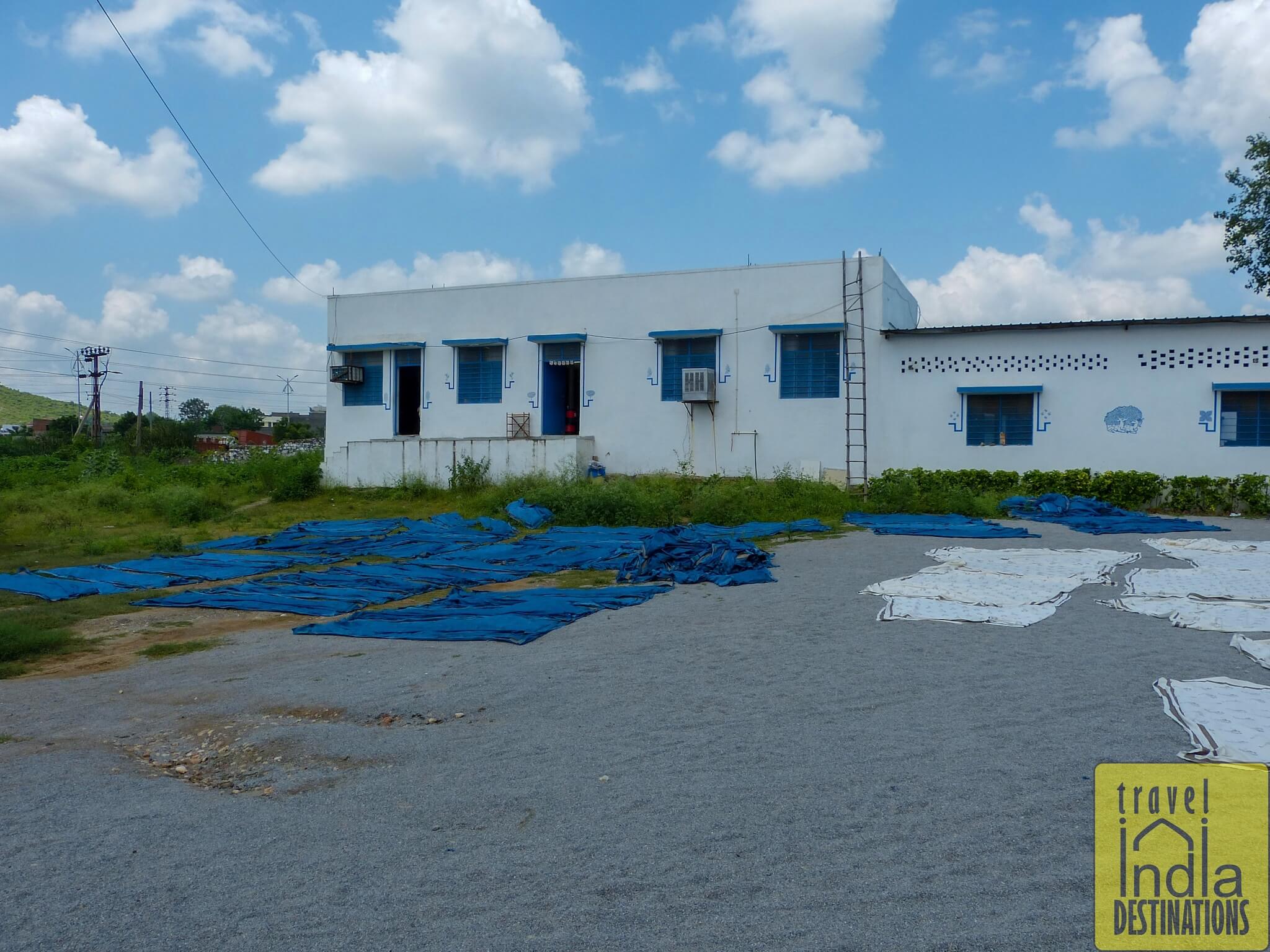
Pushpendra introduced us to the man who spearheads the dabu printing process at Aavaran.
Meet Mr Kalyanji, he’s the 17th generation daboo printing artist who knows his art like a back of his hand. He has a rock-steady hand, an exceptional hand-to-eye coordination and an eye for detail.
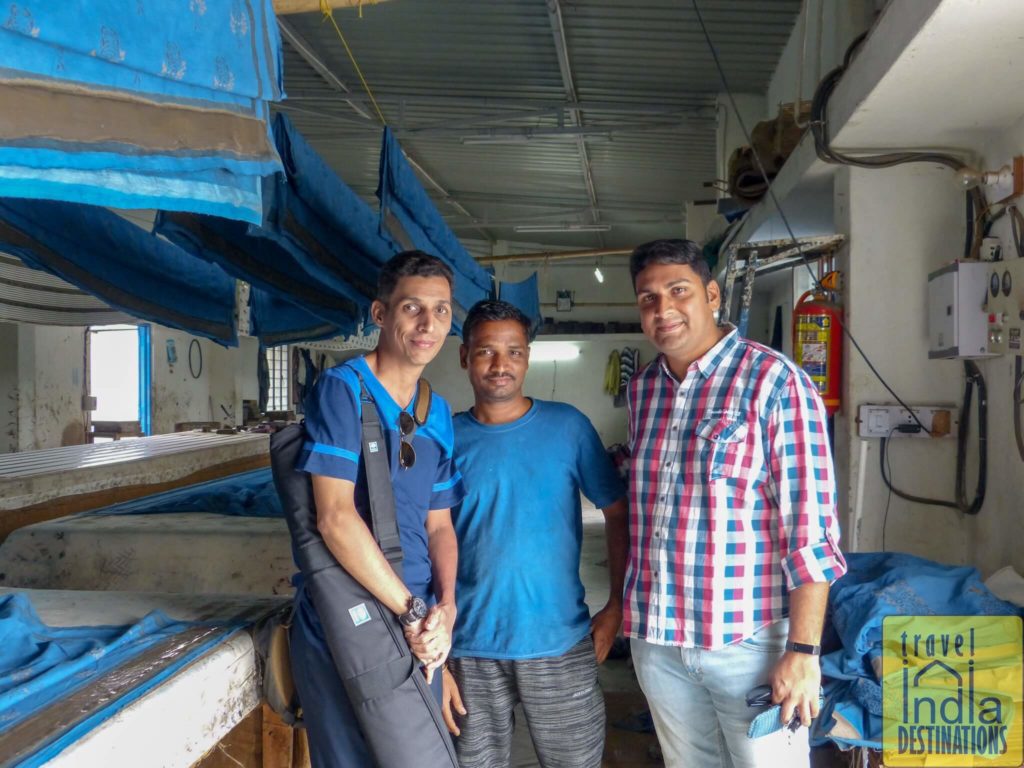
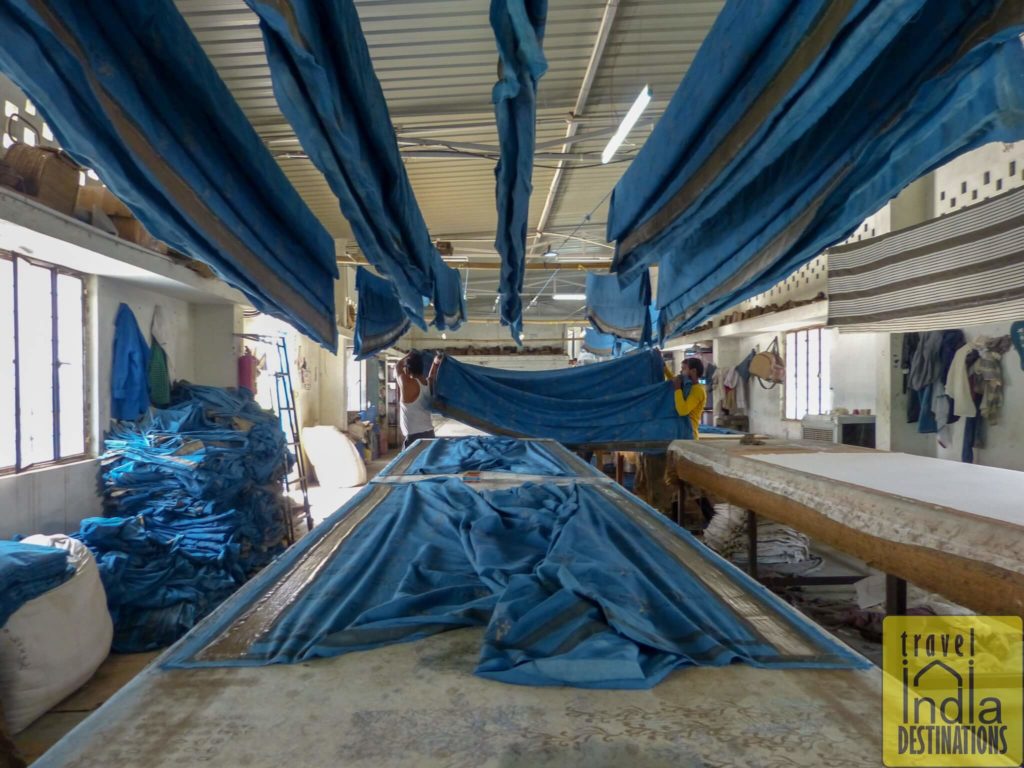
However, the thing that attracted me the most in him is his simplicity. While sorting the images I realized we were wearing the same colour t-shirts on that day. Creative minds love blue, I guess. Okay, so after the introduction, Mr Kalyanji wasted no time and took us right where the action was happening.
The Process of Daboo Printing:
- Step 1 – Washing
So, the step one is to wash the plain fabric which comes from the mills. The fabric goes through a careful washing process to remove impurities and dirt stuck in it. After washing and drying the fabric is brought to the workshop.
- Step 2 – Pinning the Fabric
The artist spreads the white fabric across the long table and pins it accurately. The fabric must not be loose, but it shouldn’t be over-stretched. Before the fabric is pinned to the table a layer of sawdust is sprinkled on it.
Why sawdust?
The reason for that is when the artist applies the mud block on the fabric, the fabric will get moist and stick to the table. A layer of sawdust prevents the cloth from sticking to the table.
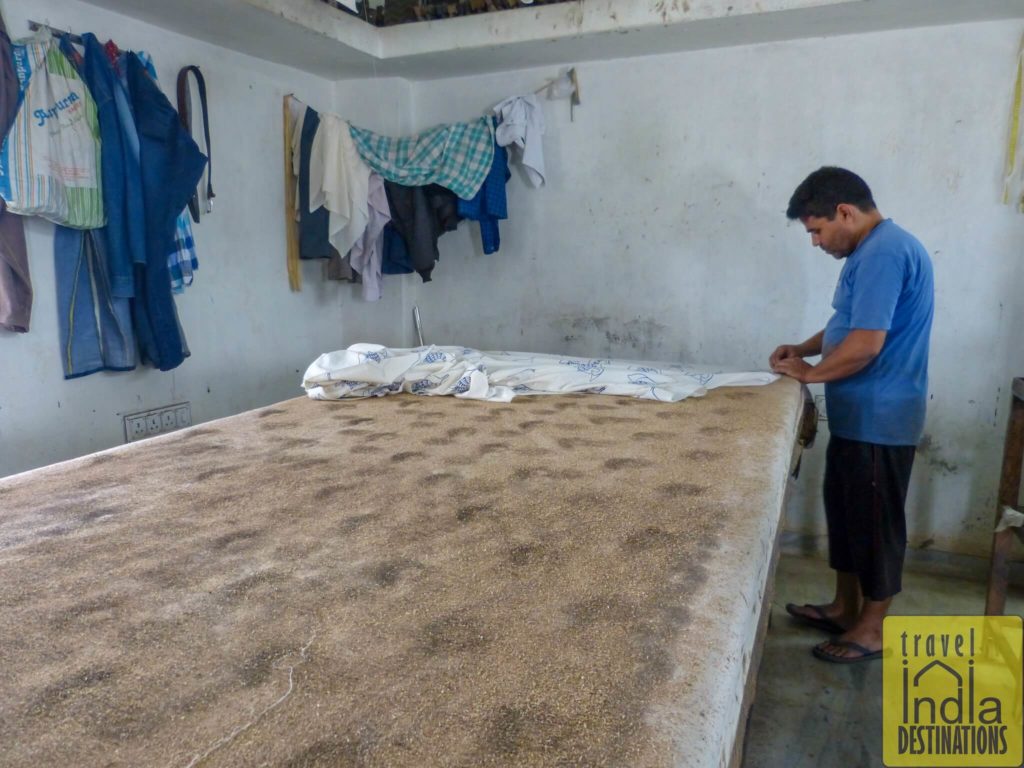
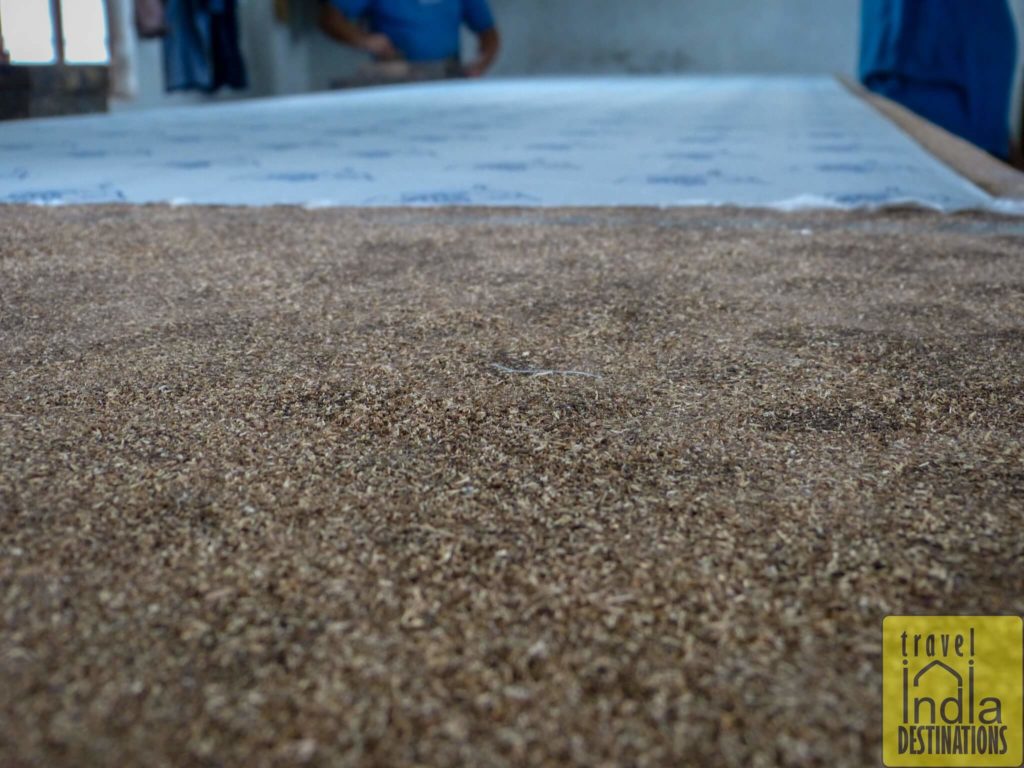
- Step 3 – Initial Print on the Fabric
Once the fabric is laid out on the table, the artist uses the block print method to print the initial prints. The blocks are dipped into fast-drying dyes. The most amazing part of this process is that an experienced artist doesn’t use any measuring tools to measure the distance between the two prints.
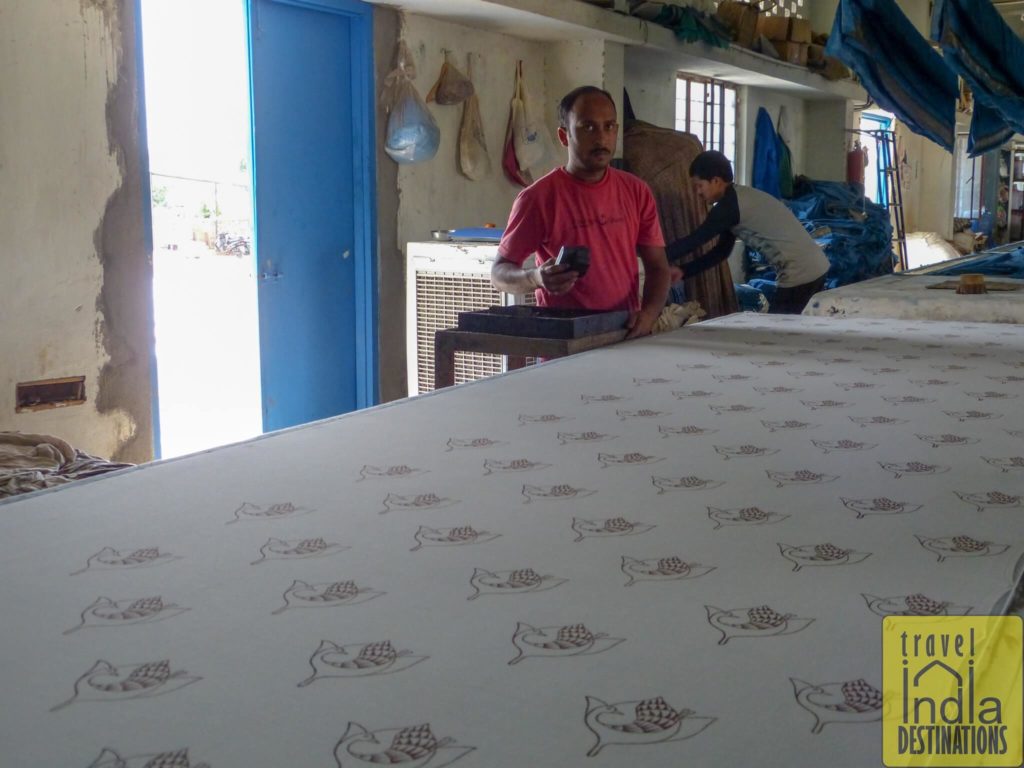
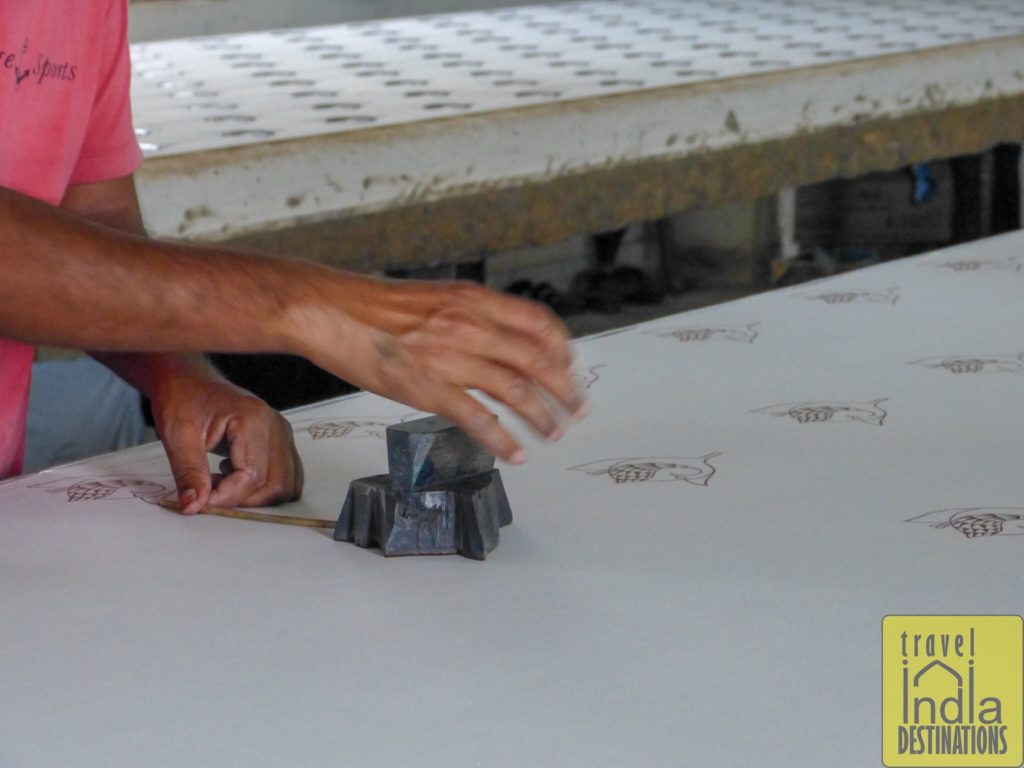
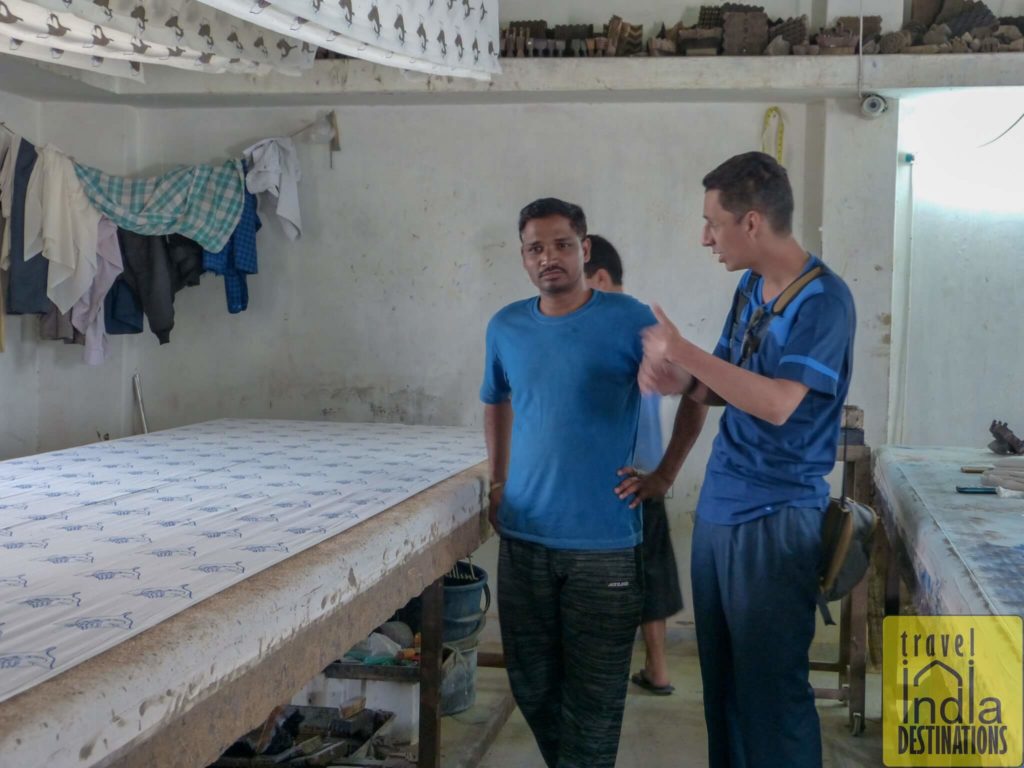
The accuracy with which they do freehand block printing is simply mind-blowing. Some inexperienced artists use a stick to measure the distance between the two block prints. However, with years of practice, they master the art of block printing with their hand and eye coordination. Checkout the video below to see how perfectly these skilled artists do freehand block printing.
- Step 4 – Mud Application
The next step is to use the mud resist print that is unique to daboo printing. So, the artist uses the block to apply the daboo paste on a certain part of the design. This part of the design will retain the original colour of the fabric.
The artist uses a wooden box known as ‘Tari‘. It has a steel mesh underneath that ensures the right amount of mud retains on the surface when the artist dabs the print block on the mud paste. It also provides the support when the artist presses the print block on the mud paste.
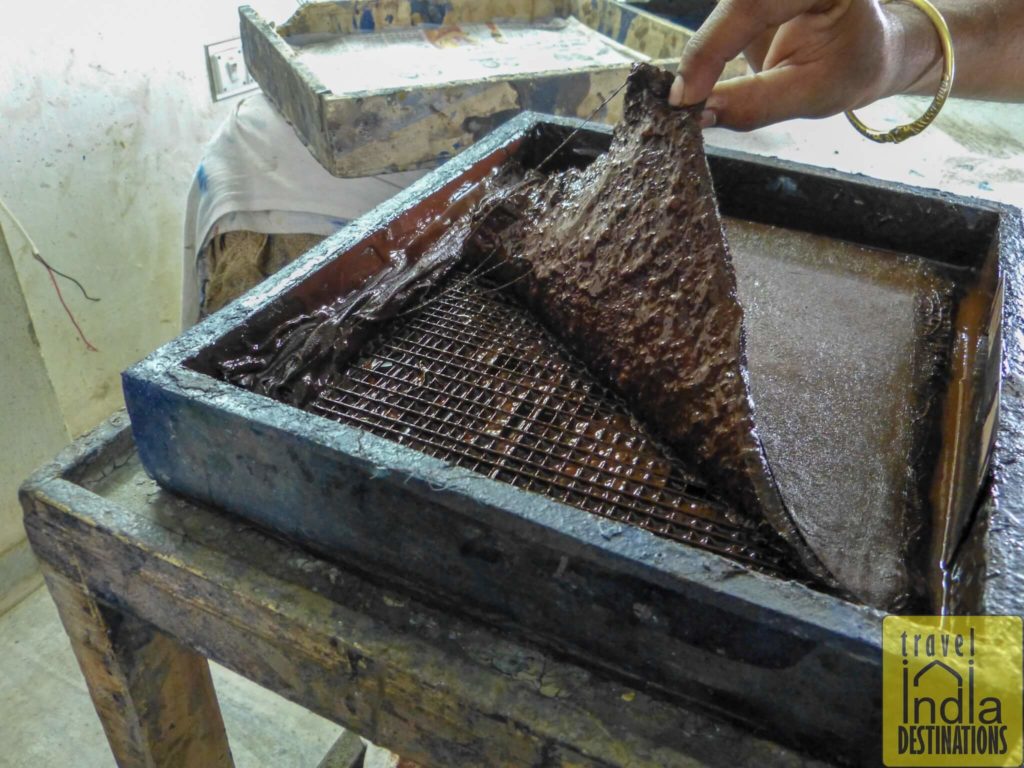
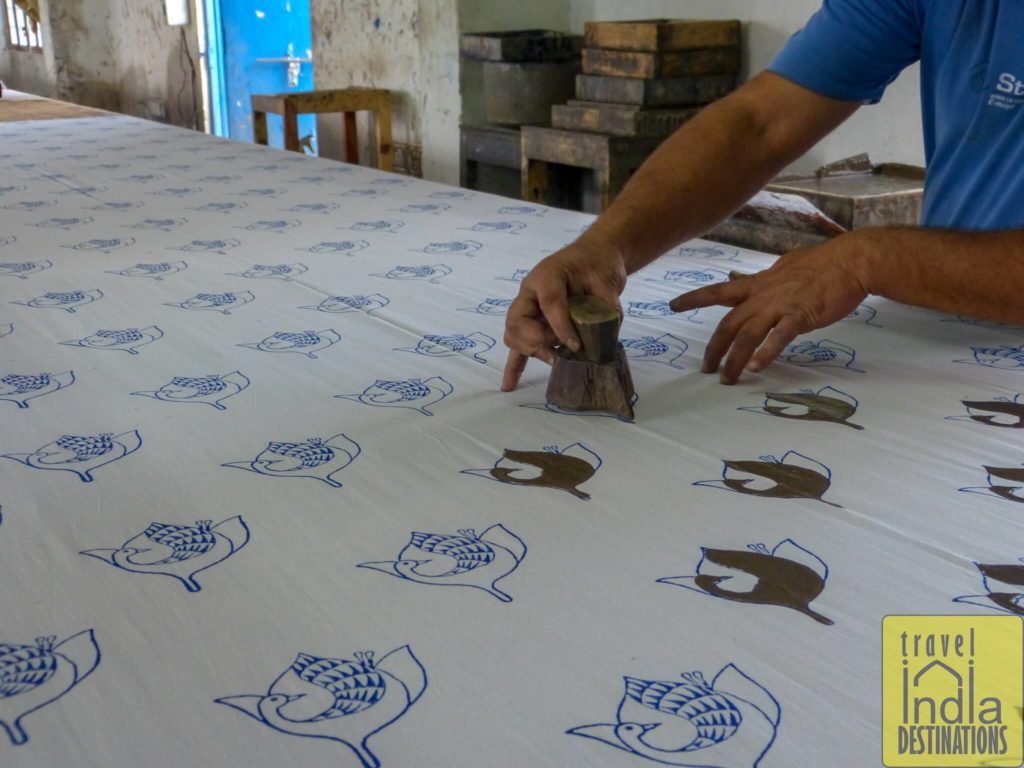
The Making of Dabu Mud Paste – A Quick Detour
The daboo printing process uses a special mud paste. This is a mixture of a distinct mud from nearby villages, gum, lime and waste wheat chaff. The paste is made manually because it has to achieve a certain level of consistency.
But why not use the latest mixing technology?
During the tour, Mr Kalyanji did mention that they tried using machines to make the paste. However, machines couldn’t replicate the consistency they need for dabu printing.
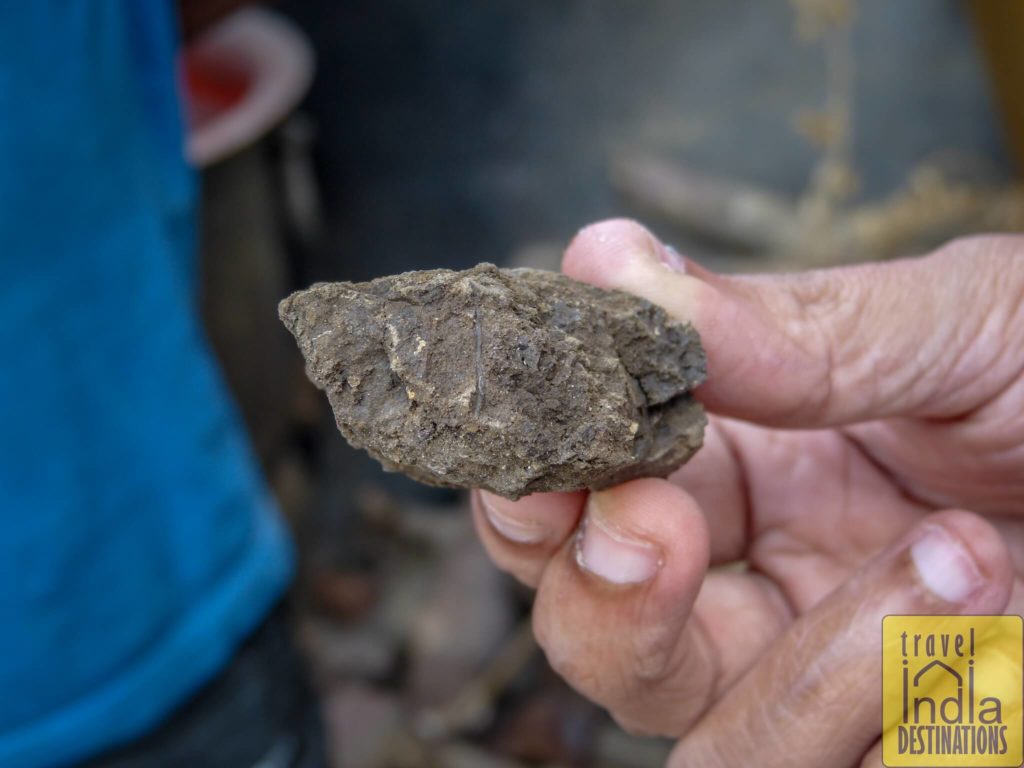
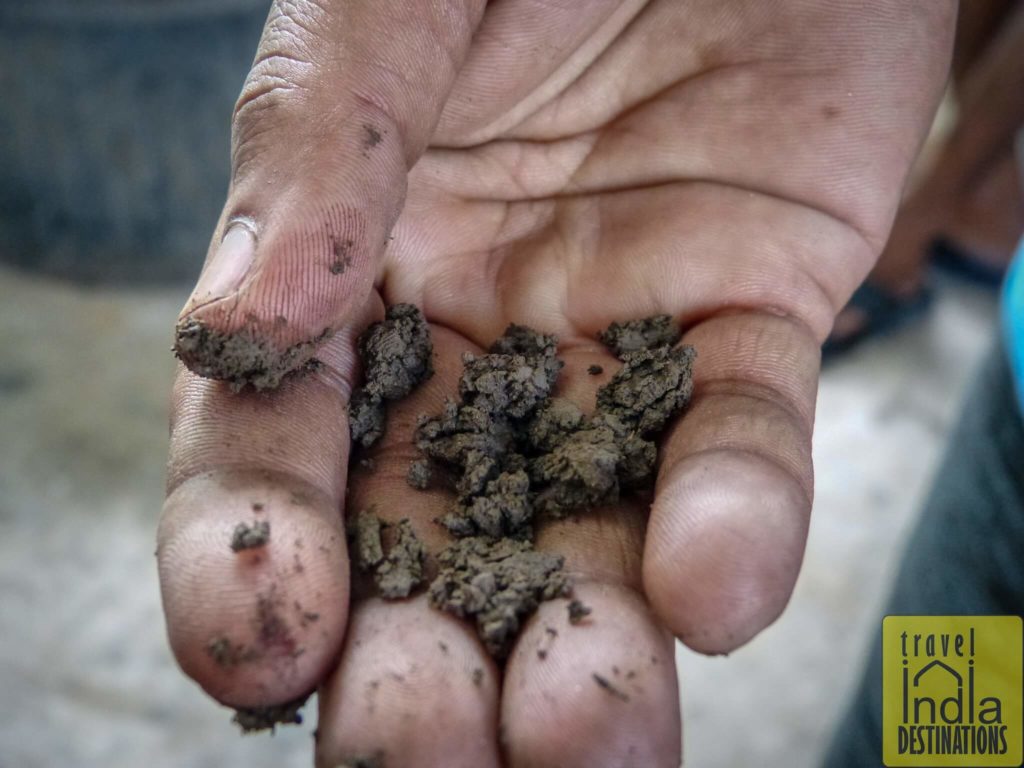
A dedicated person works on filtering the paste using a fine quality muslin cloth. He pours the daboo paste on the muslin cloth and stirs it with hand until all the fine mud filters into the vessel below. The residue left is mud impurities which goes to waste.
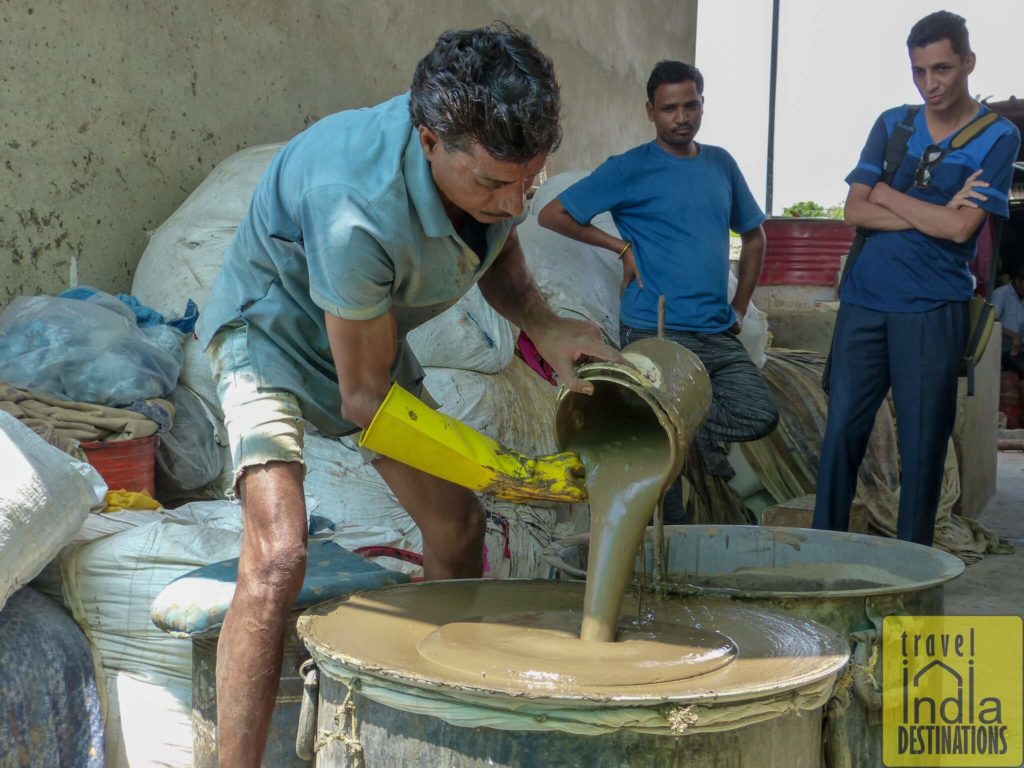
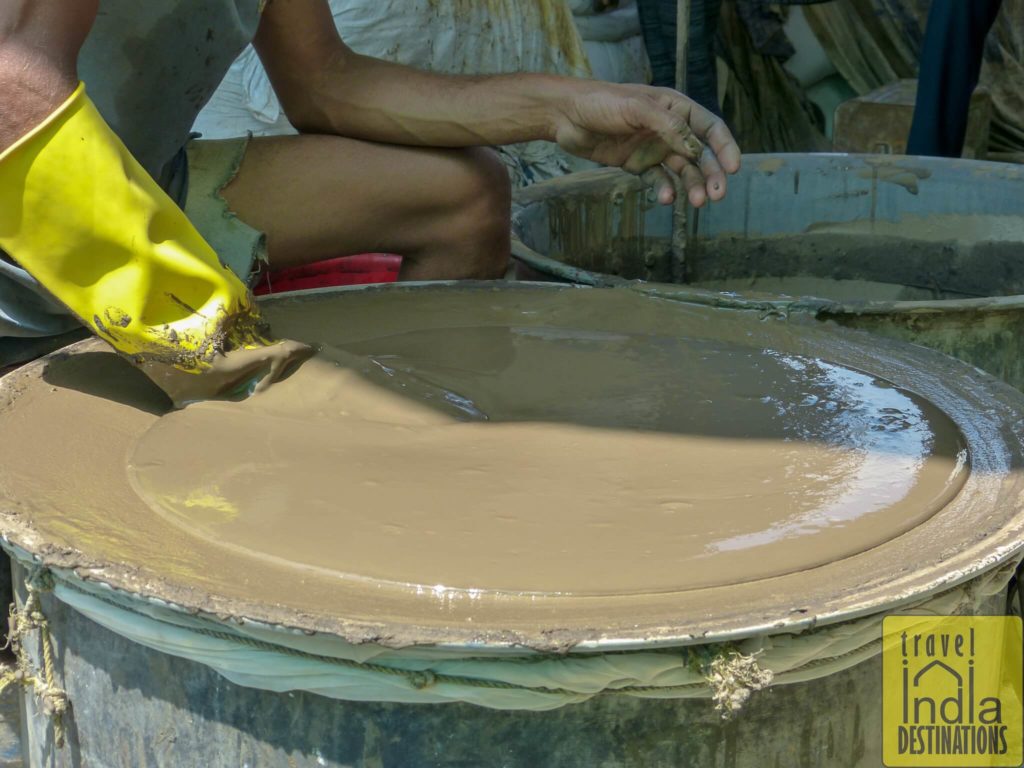
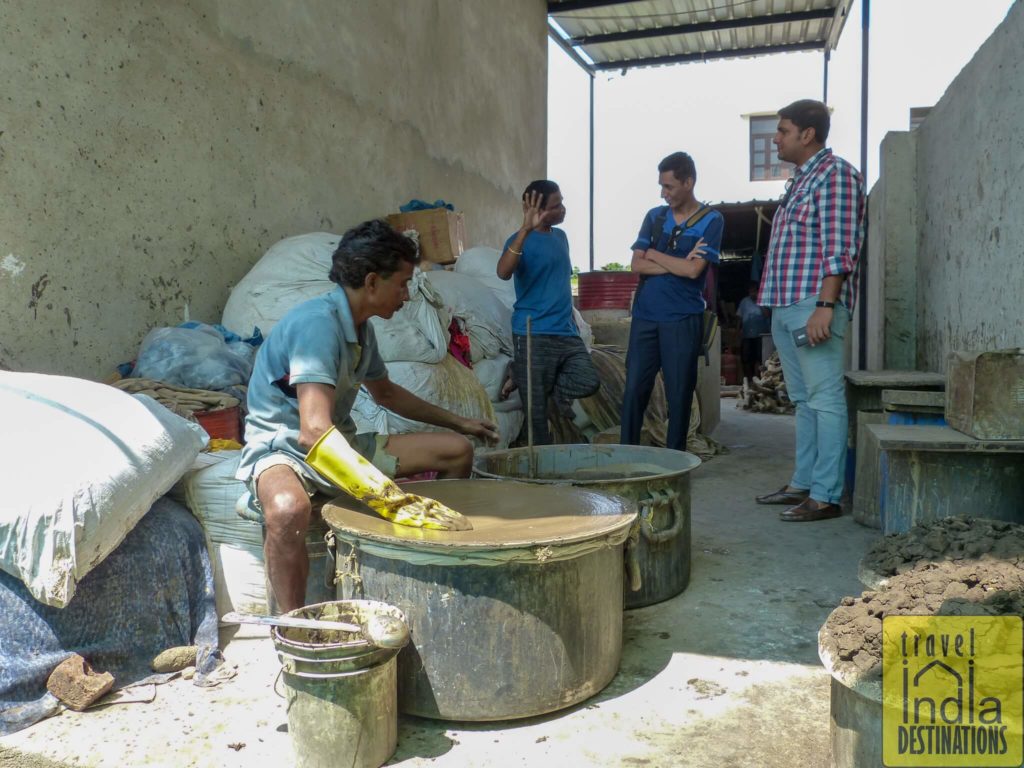
Back to the Dabu Printing Process
- Step 5 – First Drying Process
After the initial printing the fabric, it is laid out in the sun to dry. After drying the fabric goes to the indigo dyeing area. Daboo printing involves the use of natural dyes. For instance, indigo for blue shades, Kashish (a mineral produced from iron deposits) for grey and brown shades and pomegranate dye for red and yellow shades.
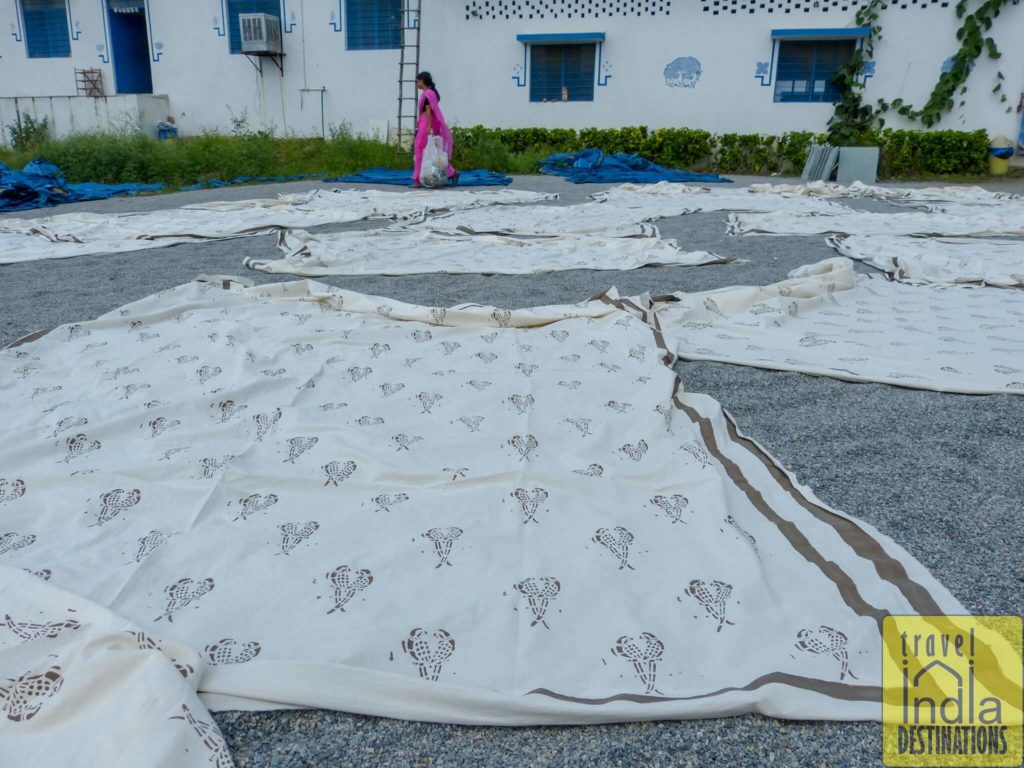
- Step 6 – Initial Indigo Dyeing Process
The indigo dyeing process is quite simple and fast. The workshop has multiple 9-feet indigo dye wells. So, after the initial design print and the first round of daboo printing the fabric goes into the indigo dye well. A dedicated worker manages the dipping process manually.
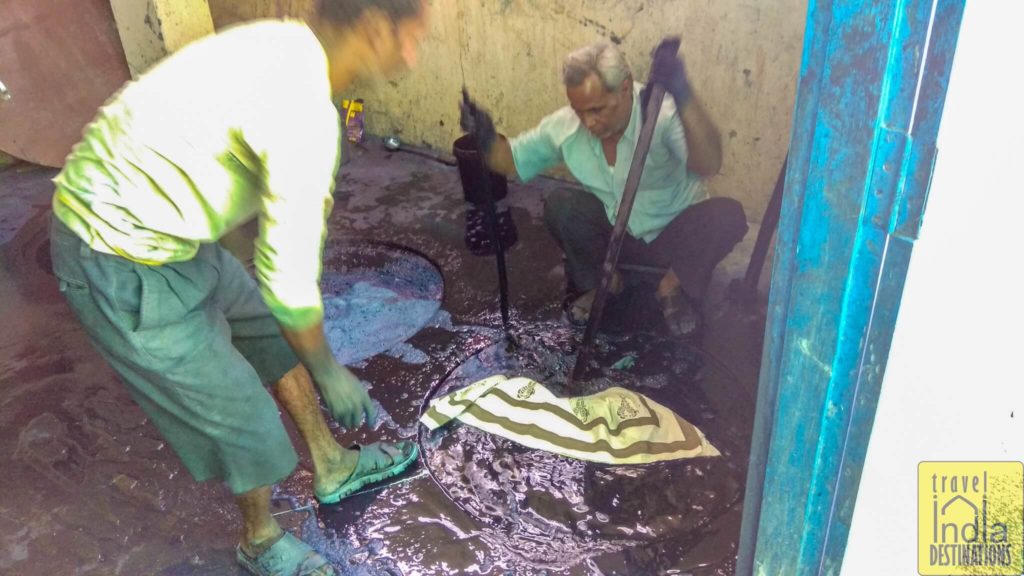
After few minutes of the dipping process, the fabric is removed from the indigo dye well. The fabric turned greenish colour the moment it was pulled out. The assisting female workers quickly laid out the fabric to dry in the sun. However, the moment it was exposed to the sunlight the greenish colour fabric turned indigo-blue.
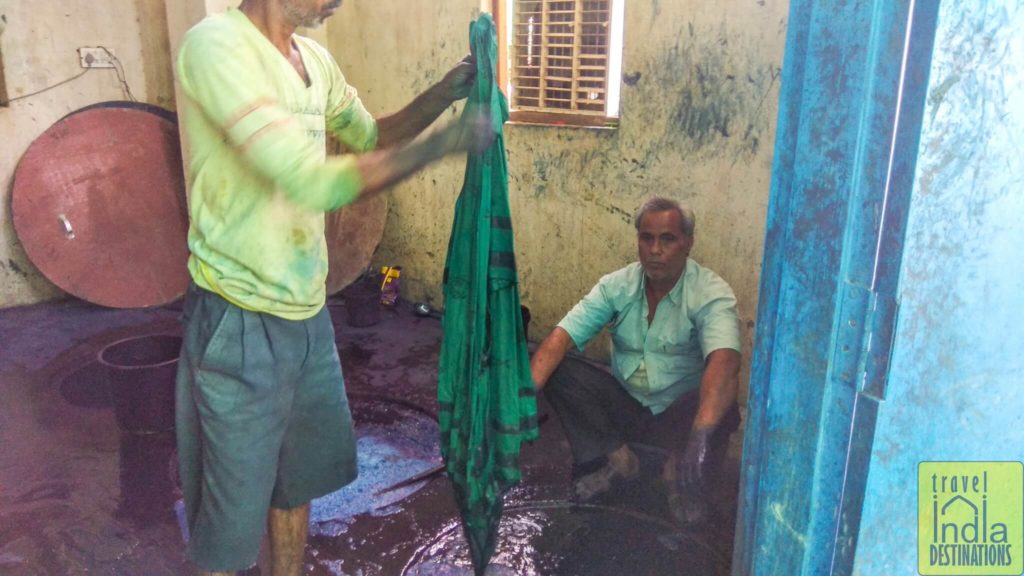
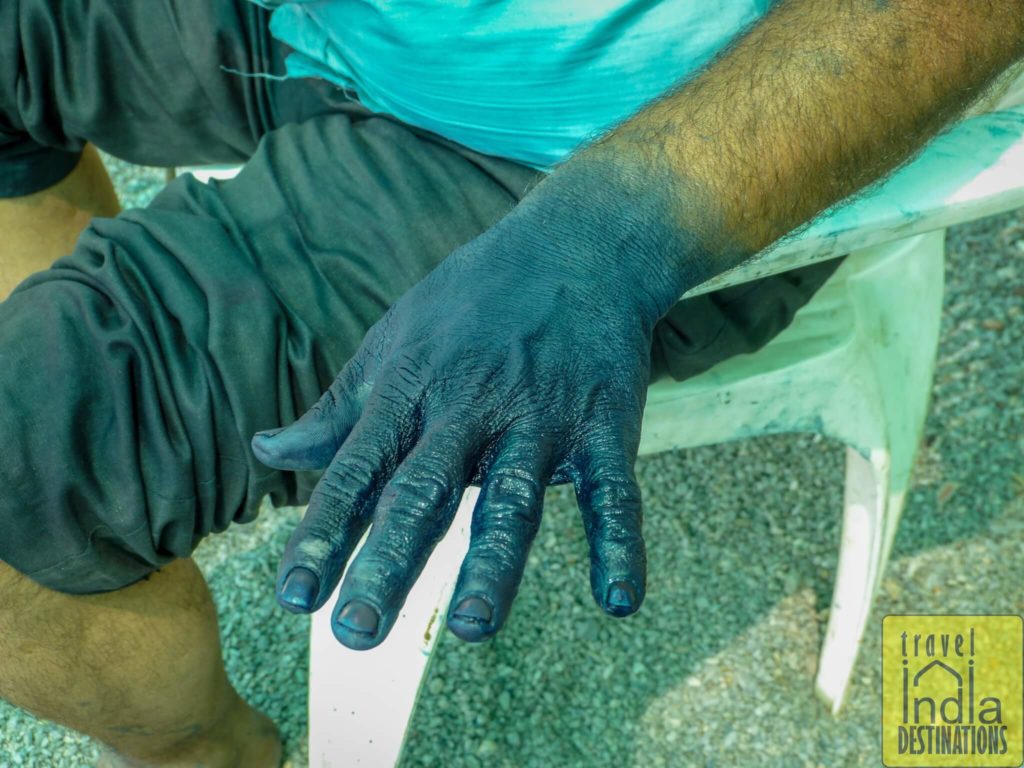
At this stage, if the requirement of the client is single-daboo treatment then this fabric would go to the washing department once it dry. However, some companies demand double-dabu and triple-dabu treatment. See the indigo dyeing process in the video below and see the fabric colour changing from greenish to blue.
Hence, in the case, of double-daboo treatment, this fabric would return to the workshop after drying out in the sun. The artists would now apply the dabu paste to another part of the design using the block. The fabric would then come out to dry in the sun and goes for another dip in the indigo-dye well. It undergoes the drying process thereafter.
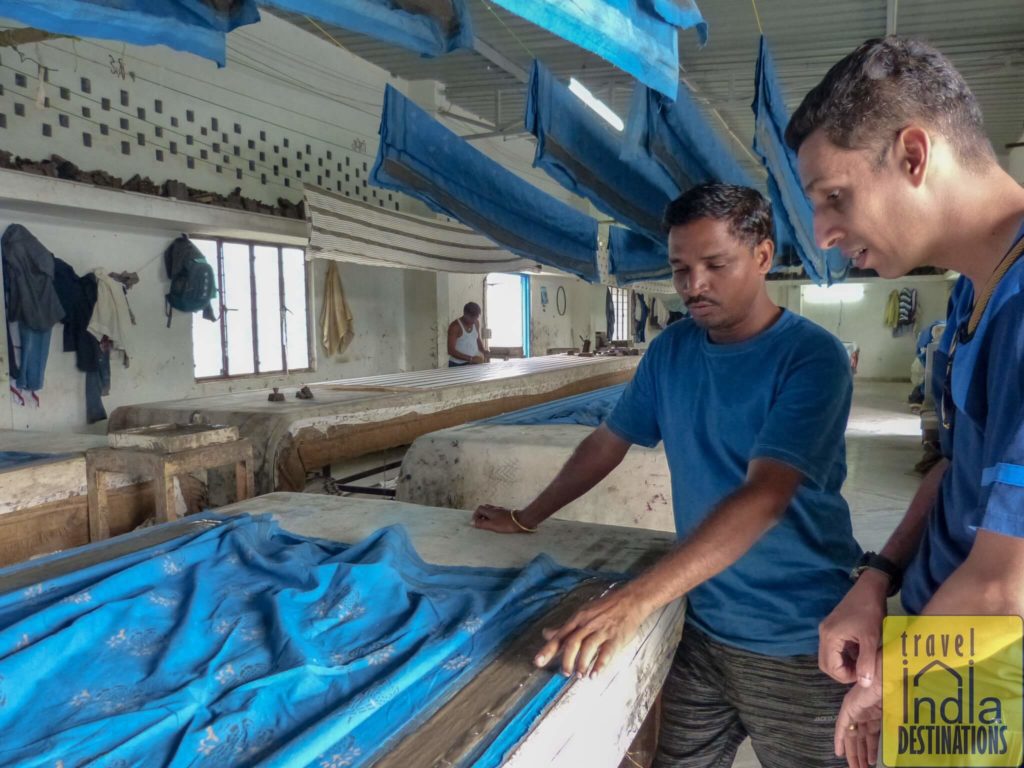
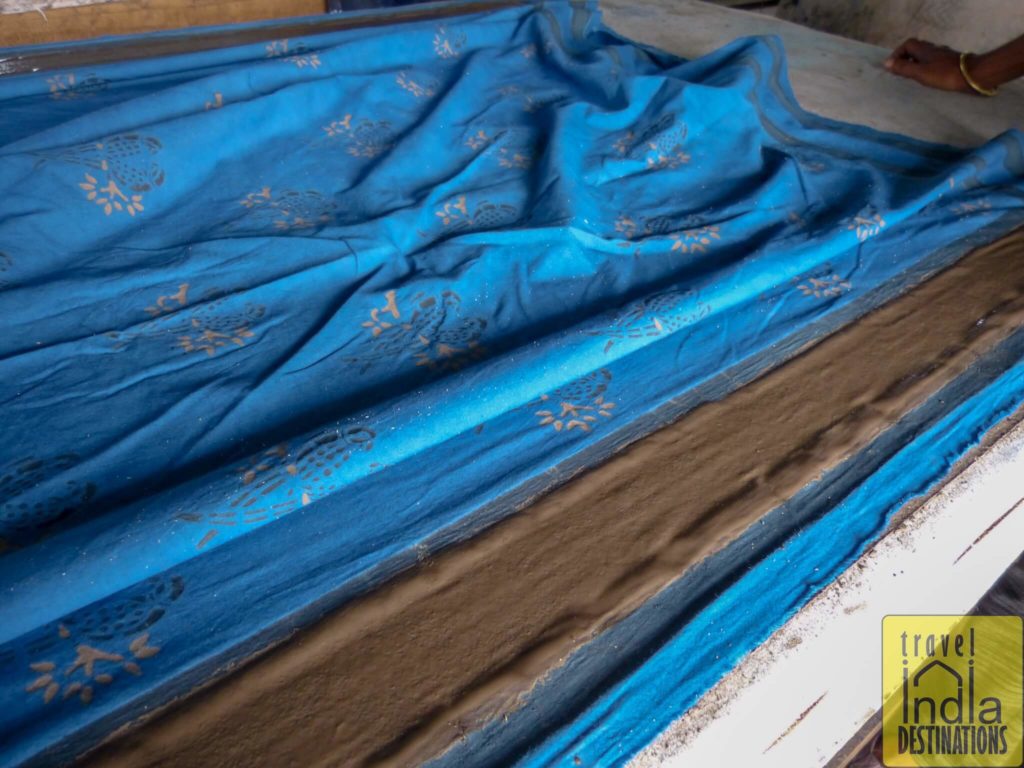
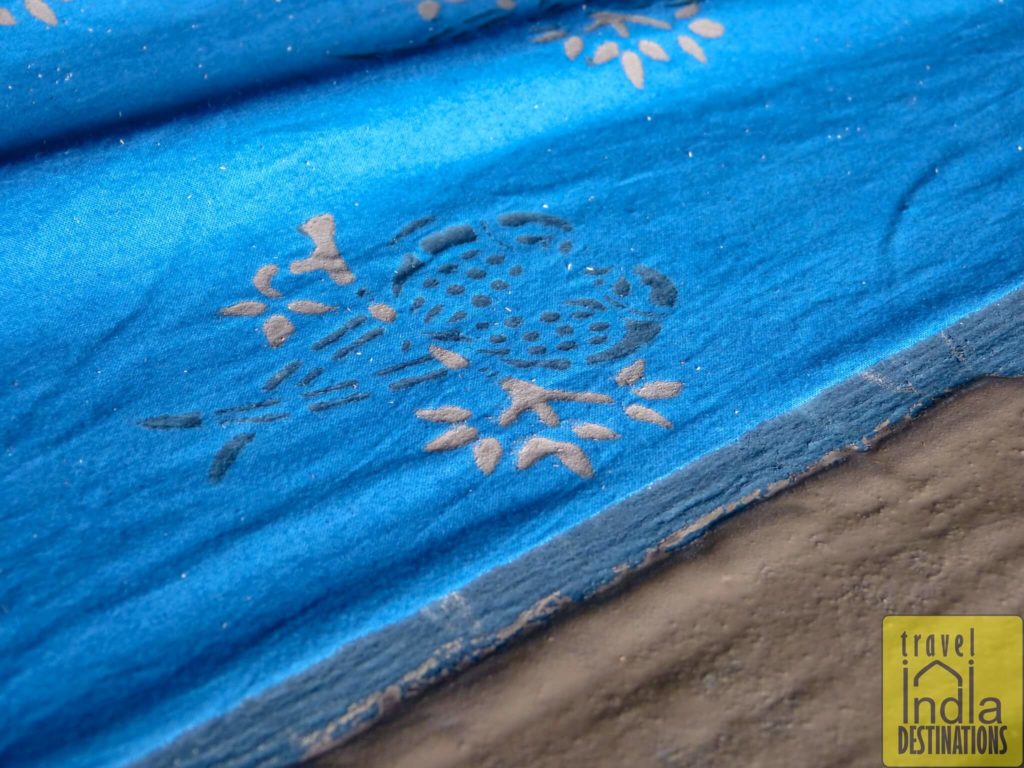
Initially, when the fabric was white, daboo mud was applied only to the parrot design, not the branches. After the first indigo dyeing process the white fabric has turned light blue. The dabu mud on the parrot design has turned black, but it has prevented the indigo from penetrating into the fabric. So, the parrot design will stay white.
The second layer of daboo mud (in the pic above) is applied to the branch design and the thick border. After going through the second indigo dyeing process the light blue area will turn dark blue. Since the branch area and the thick border area had dabu mud paste the fabric underneath will stay light blue.
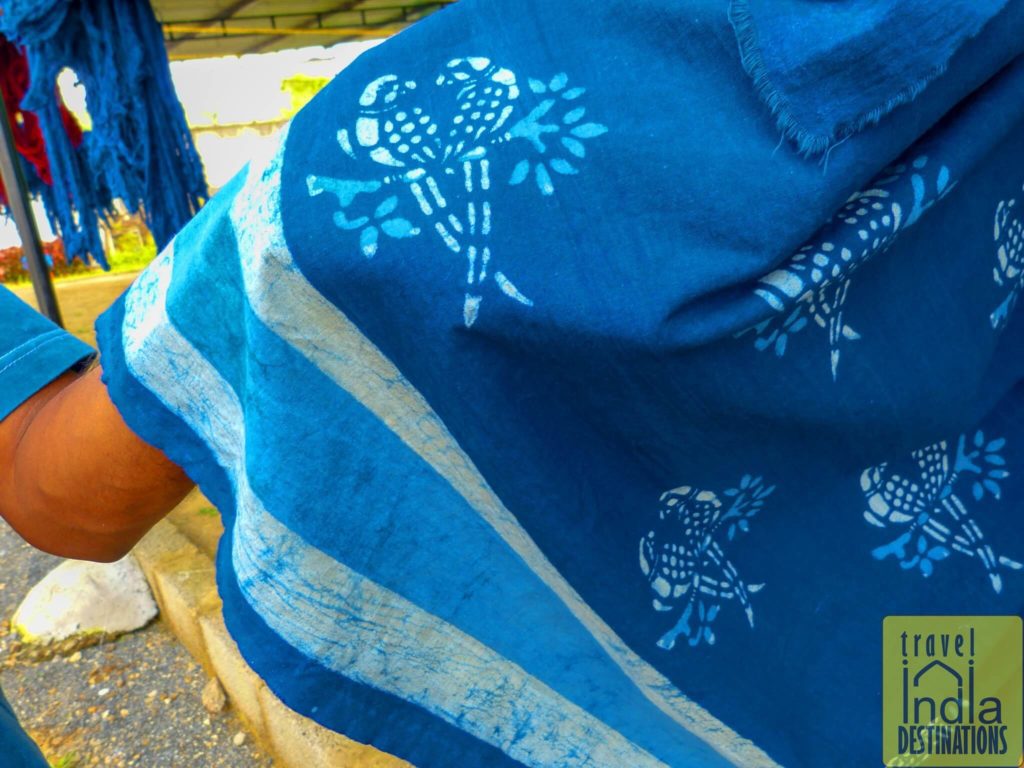
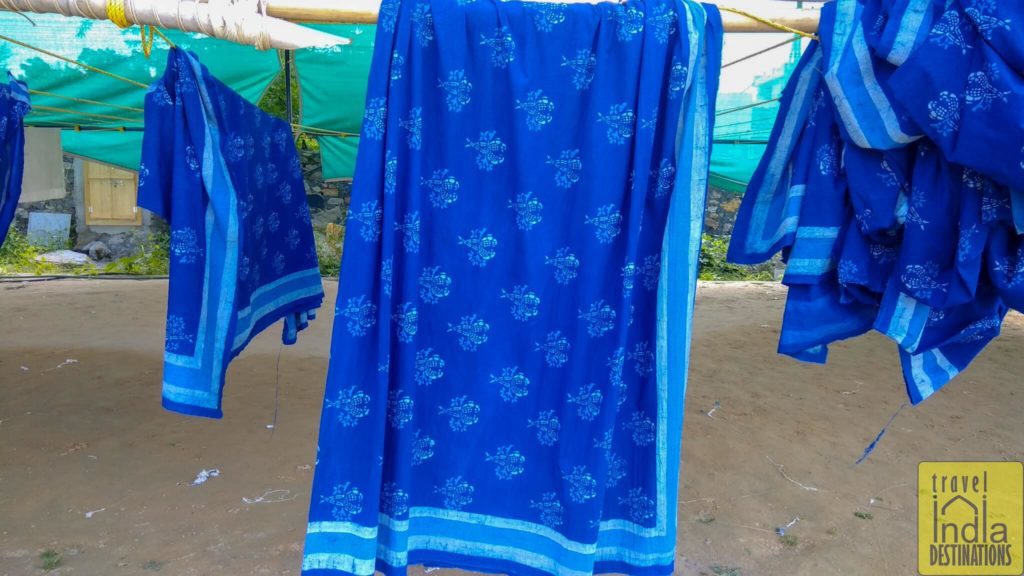
In the case of triple-daboo treatment, the fabric would return to the workshop again and the same process would be repeated. After this, the fabric finally goes to the washing department and the final product is made.
The Washing Process:
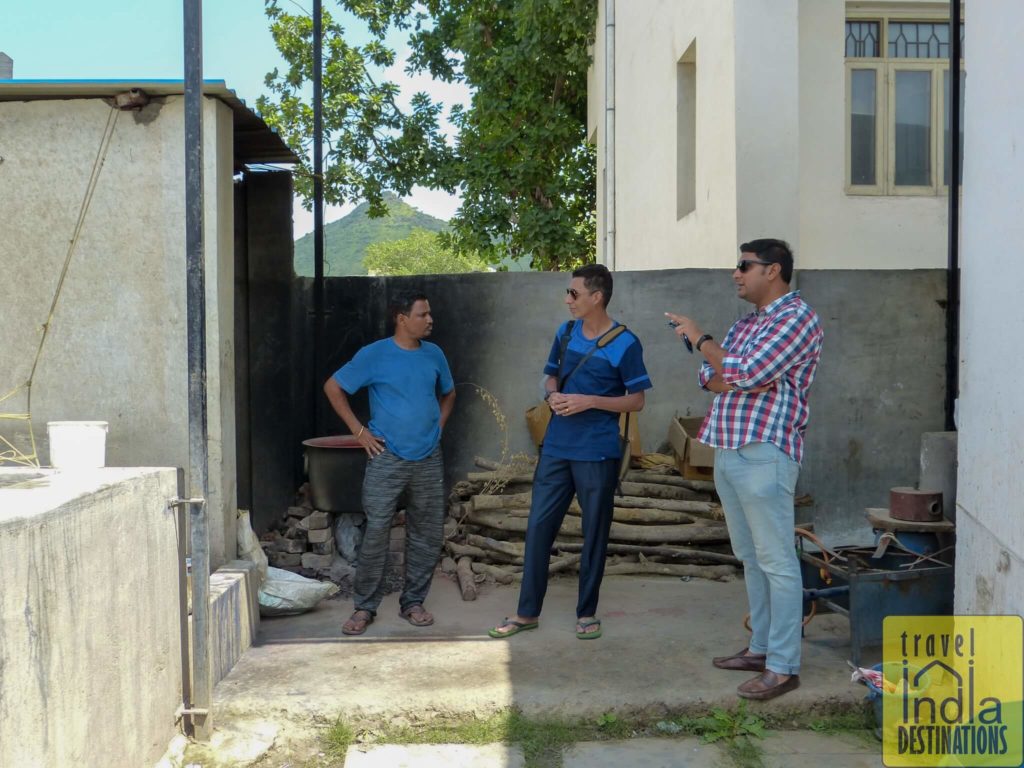
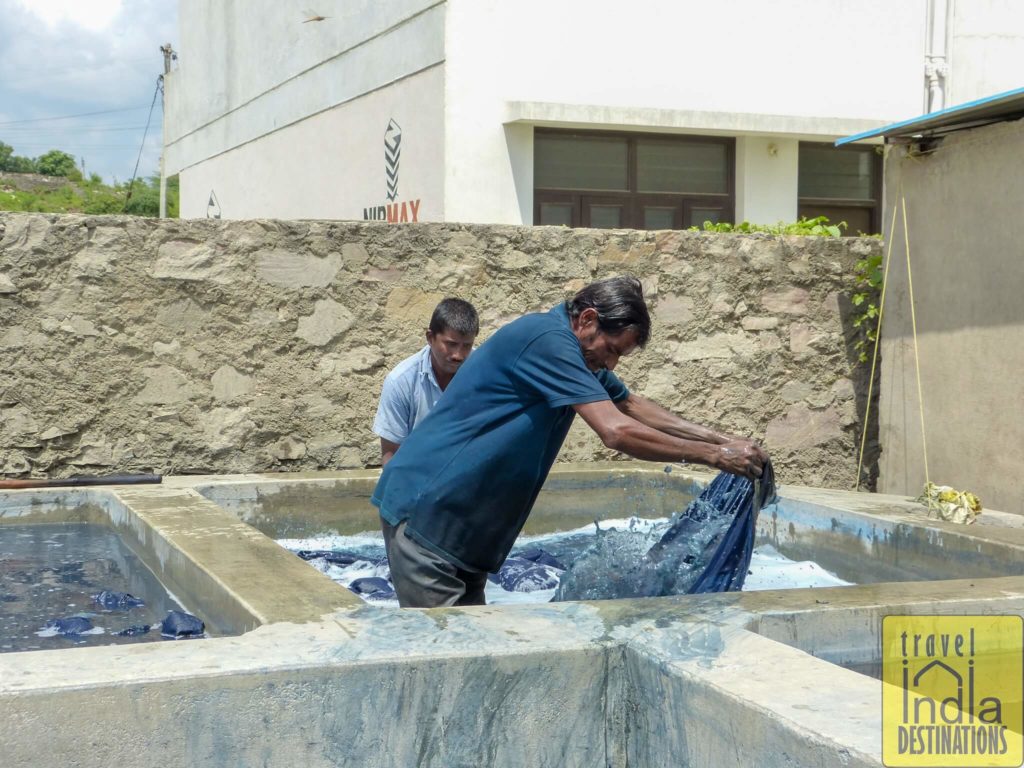
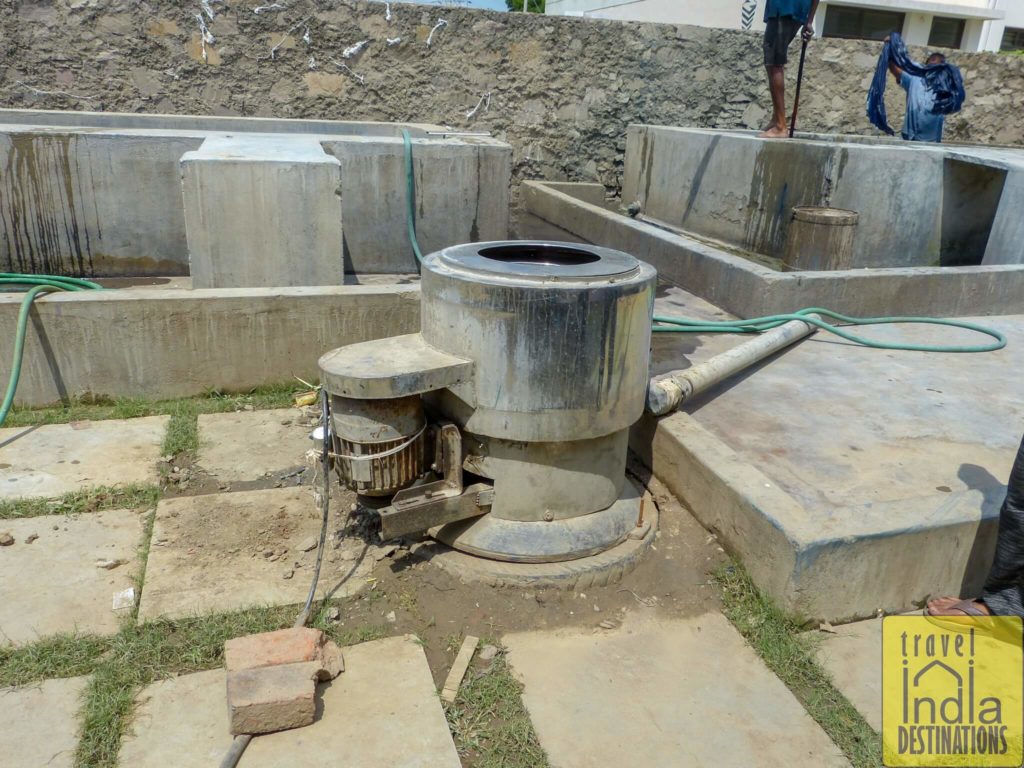
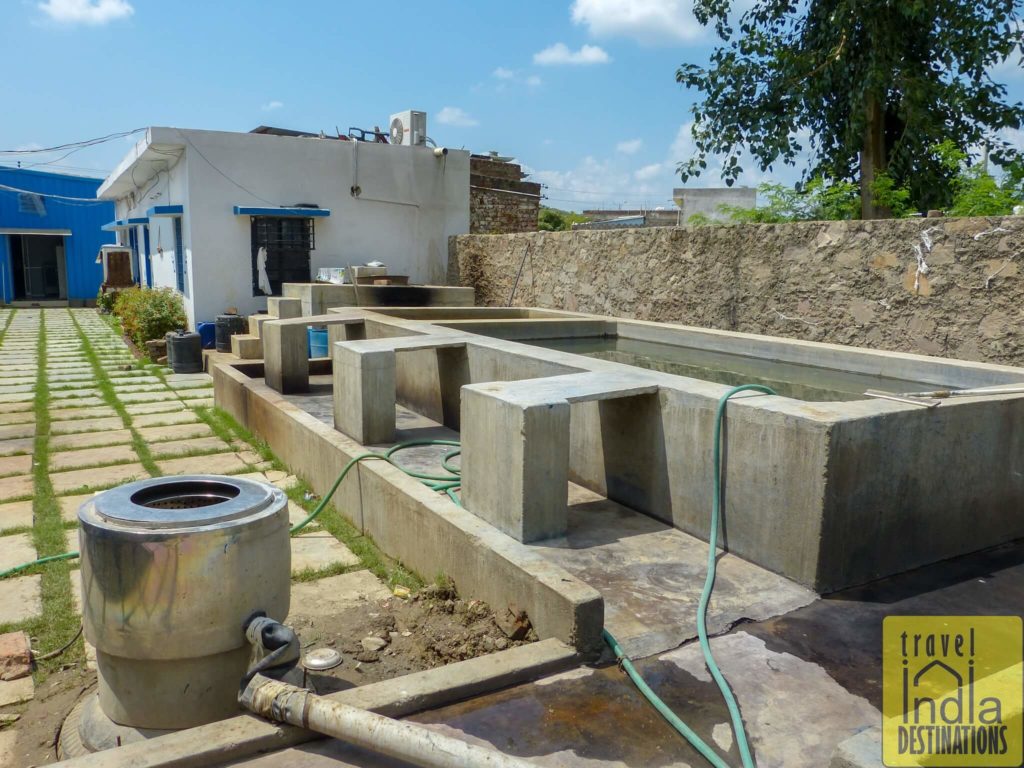
Other Areas of the Aavaran Facility:
Our visit to Aavaran was not just about experiencing daboo printing, but beyond. So, Pushpendra and Kalyanji took us to other areas of the facility that focuses on other areas.
Right at the start, we saw bundles of plain fabric from the mills. The clients that want to get the dabu printing work done would send in their requirements. After a couple of discussions with the company and finalizing the print, colour and other formalities the process begins.
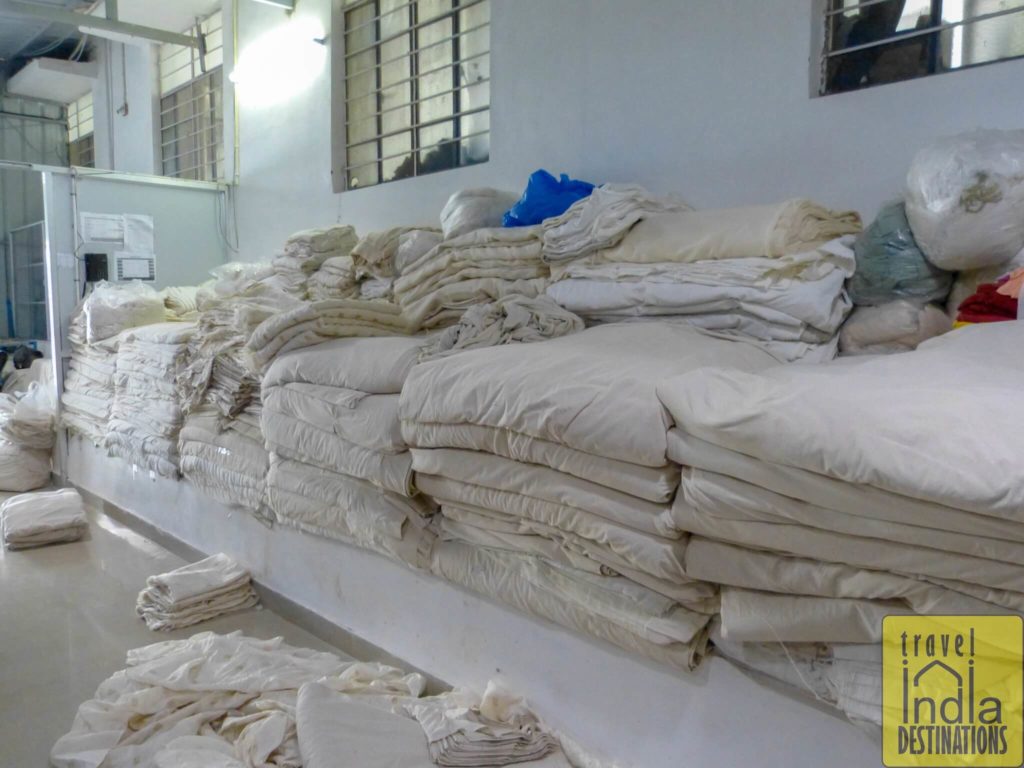
Graduates from NIFT (National Institute of Fashion Technology) work here on various projects and lineup. They have their own work station where they create intricate designs using natural dyes and print motifs. This section usually has pre-cut templates of different sizes that these students use for designing clothes. There are tailors present who work in coordination with these students.
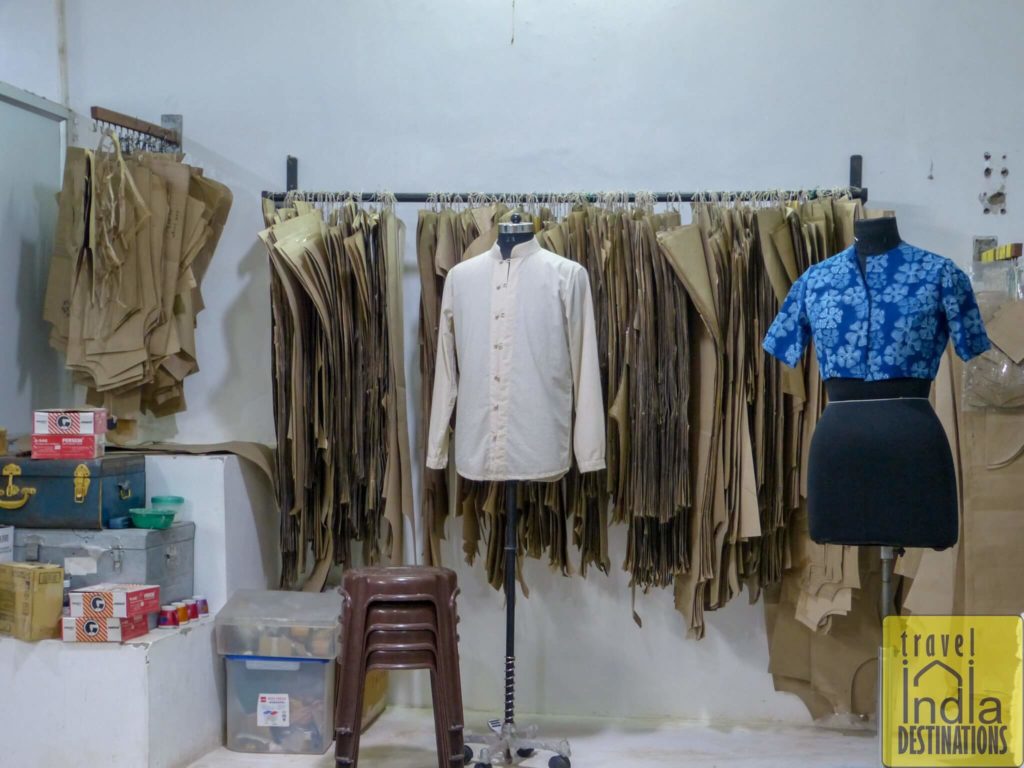
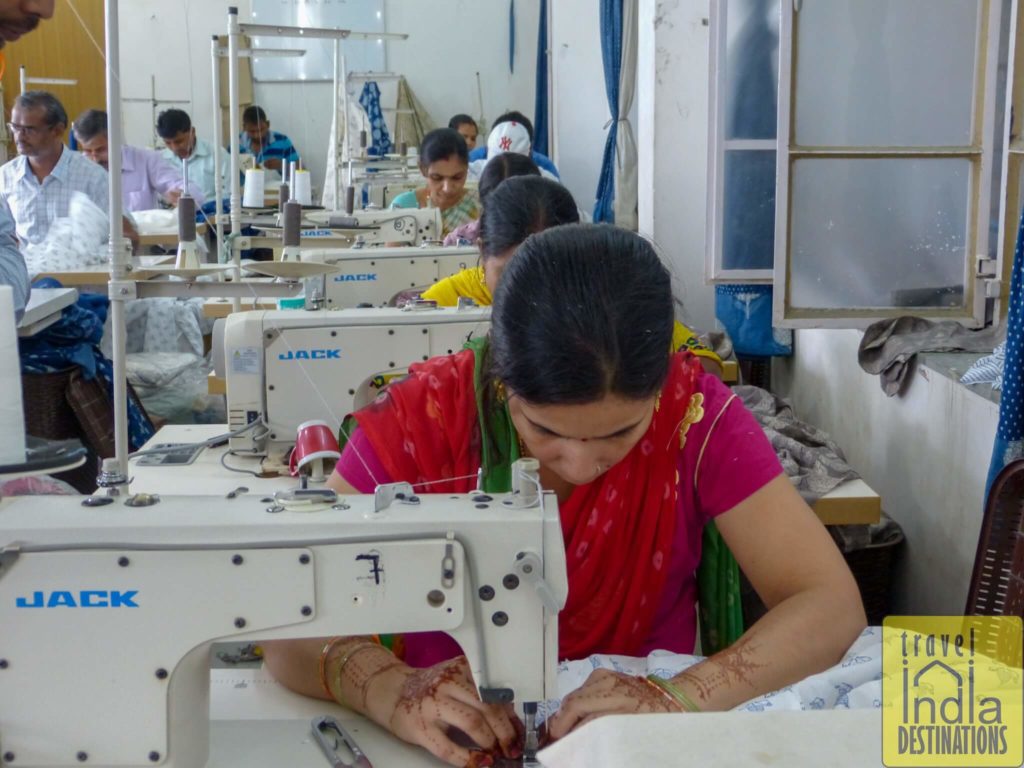
Aavaran is an Udaipur-based NGO that focuses on empowering low-income craftspeople through education and income generation programs. The organization also emphasizes evolving and sustaining traditional crafts and to make rural artisans self-reliant.
To combat the issue of migration for work, Aavaran in collaboration with Hindustan Zinc Ltd initiated project Swavlamban (which means self-sufficiency). This project focuses on making rural and tribal women self-reliant and self-sustainable. Women and girls receive training on various aspects of textiles, and personal health and hygiene.
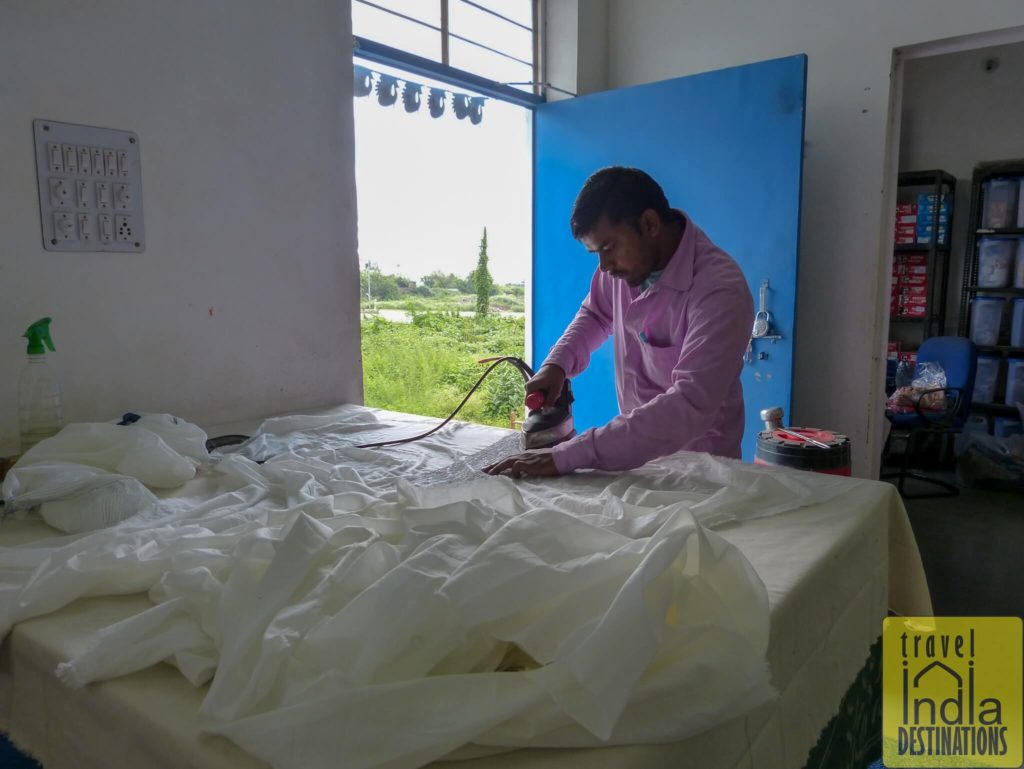
The facility also has a section for ready-made products. If you visit this place you can always come here to buy some great fabrics at the right price. Our tour ended with me and Sarah shopping for some items for us. Overall the experience was quite memorable as we got to interact with the local artisans and workers.
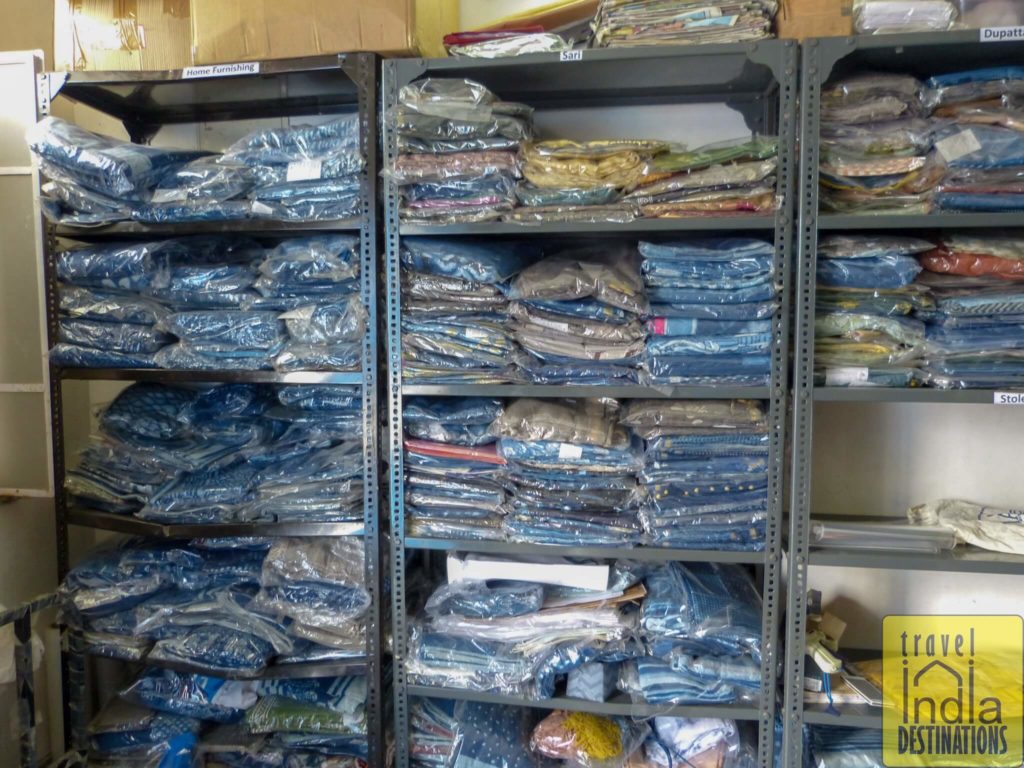
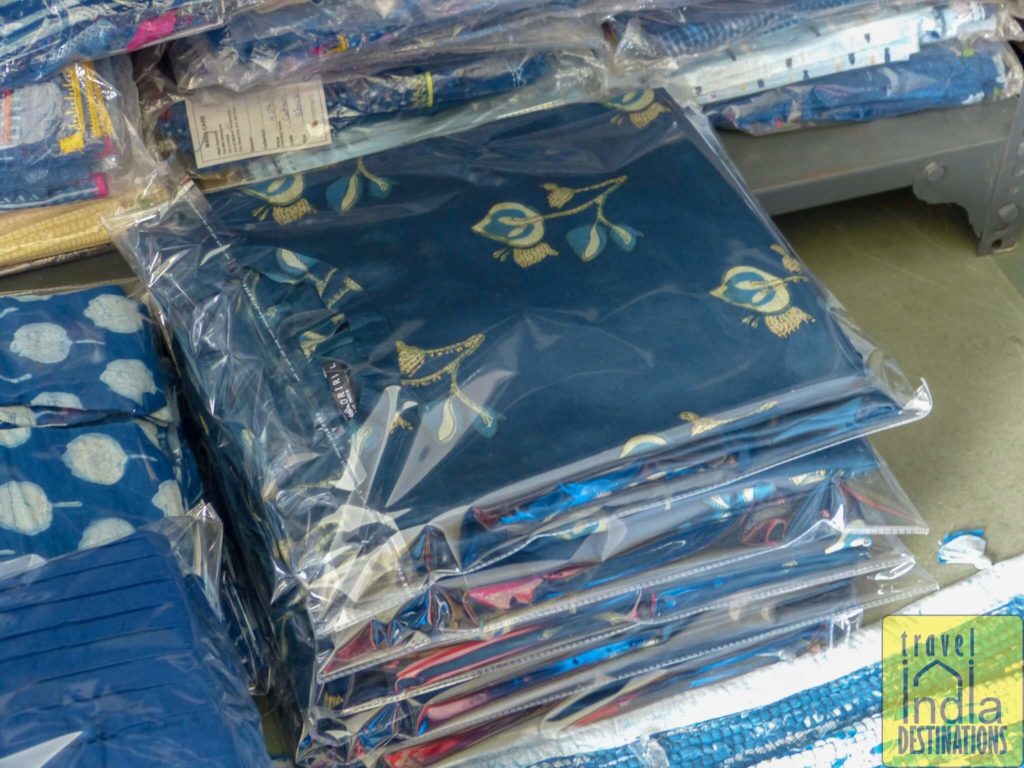
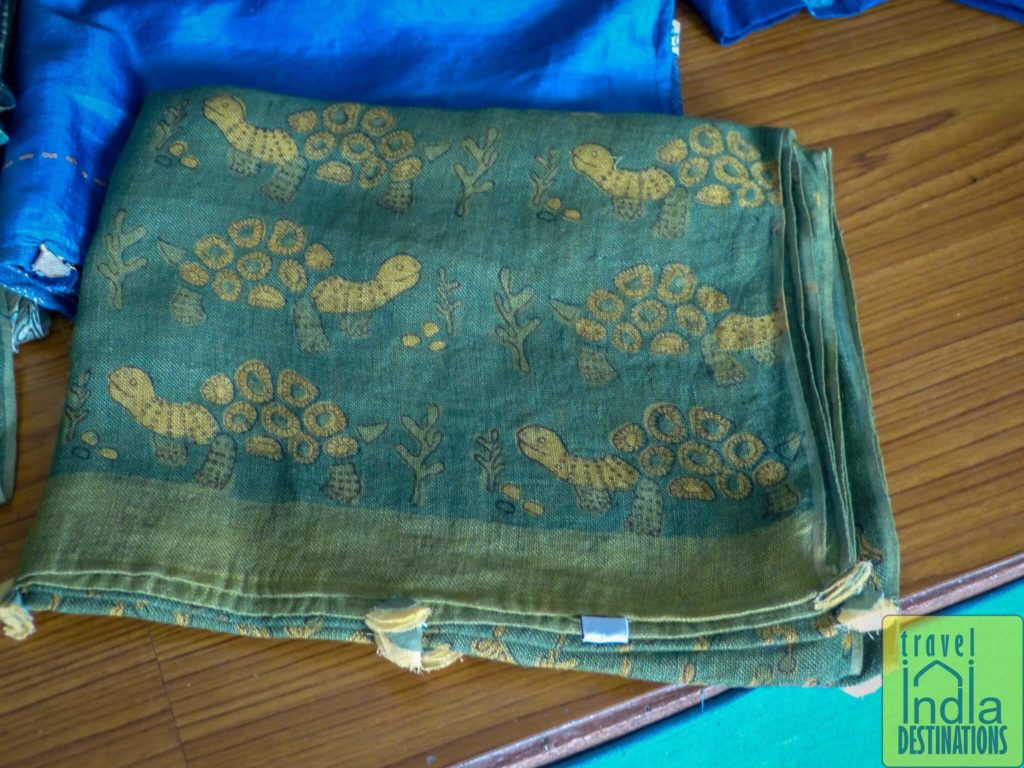
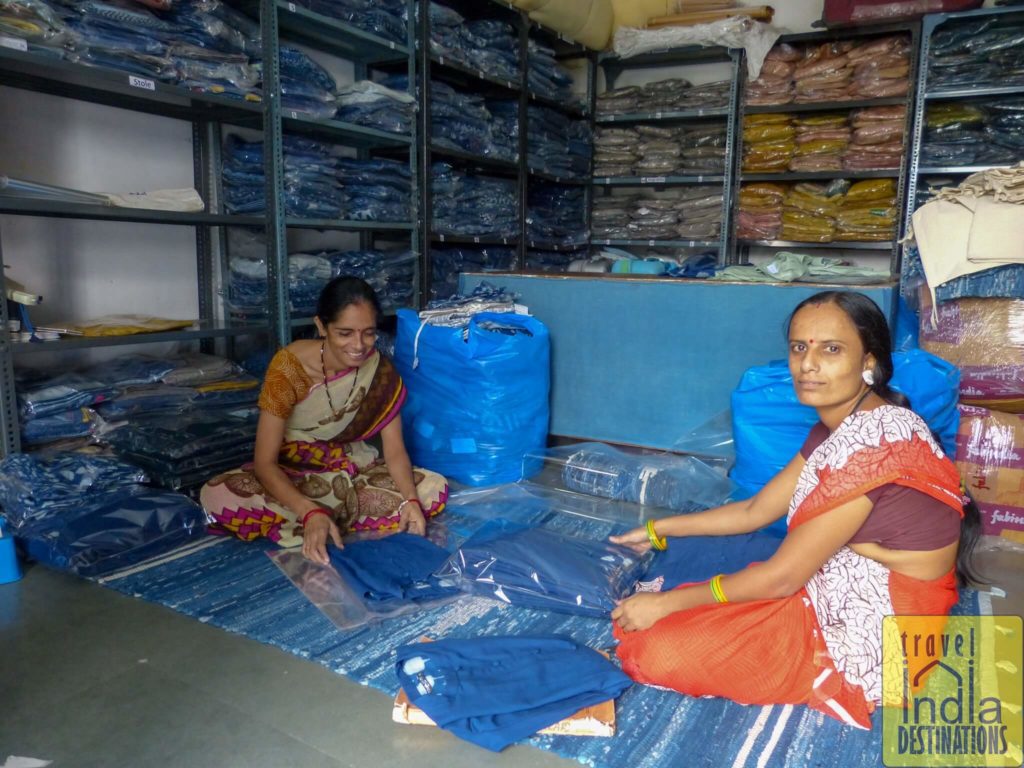
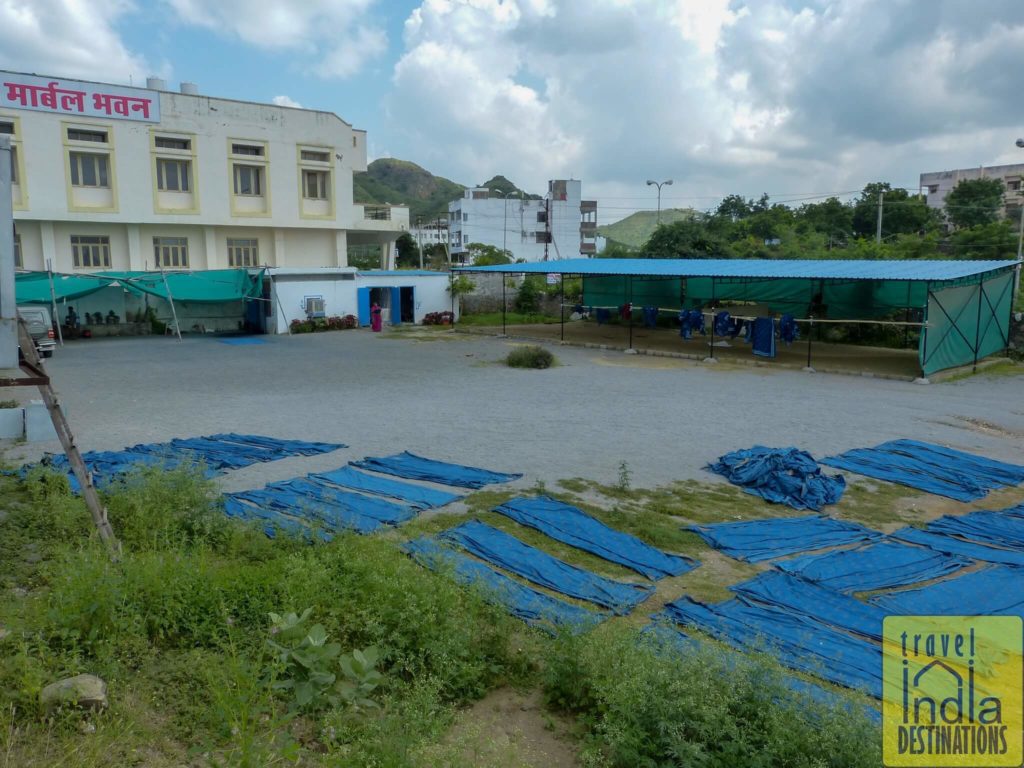
Visiting this dabu printing facility was not only a learning experience but an eye-opener as well. It was a great trip where both I and Sarah got to learn about traditional printing techniques. Of course, Sarah is behind the camera for most part of the tour so all the images you see are hers.
Also, we both got the chance to meet the artisans who have been working in this facility for decades. A big thank you to Mr Kalyanji for sharing knowledge about his craft and techniques passed on through generations. Thank you to Pushpendra Shaktawat for taking us here and meet the people who make a difference in their special ways.
If you enjoyed this dabu printing facility tour do explore my other travel blogs on the site.
8 comments
The process is fascinating, Sharukh. Labor intensive, for sure, but I can see how it would be hard to replicate the quality. It’s sad that we often settle for something close and inexpensive, but it’s nice to know that there are people who still know how to do this.
You did a wonderful job of walking us through the process.
I saw this process in a dabu printing YouTube video and from that moment I wanted to cover this. When I was in Udaipur I approached Walk and Pedal Travel Tours for it and thanks to Pushpendra who made it possible for me. It was a great experience meeting rural artisans and workers and interacting with them so closely. Sarah was behind the camera but she also enjoyed the process. I wanted to cover this because there is not much content about daboo printing on Google. After visiting the facility the only challenge for me was how I can add so much content in one post. I wanted to make this interesting and not boring because there are no landscapes and eye-catching pictures to engage the audience. I’m glad you liked the post. Thanks for dropping by, Dan.
This took me back to another life, Sharukh. I’d love to come along with you and Sarah on a similar trip some time.
Sure. However, I think Udaipur is a place that you should experience with your husband. You can feel the romantic vibe in the air when you are in Udaipur.
It is loss on my part that saw this article today and i visited Udaipur last week. so much waned to see the way printing takes place .
Thanks’ though for taking me through, through your article .
Would certainly want to know more but the prints and he weaves .
When you see the block printing happening in real you will be in awe at how precise these artists (I won’t call them labourers) are in placing that block on the cloth. It takes years of practice and skill to do what they do. I was in Jaipur last week so more blogs coming up on Jaipur travel and artists. If you want to read that stay subscribed to my blog so you get the update in your email. It won’t be this month, but the posts will come up soon. I have so much content and images to sort and write. Thank you for reading my post and visiting my site. There are more posts on Udaipur on my blog already so do read those as well. Take care Monica. Stay safe.
What a wonderful memory for you and Sarah. I enjoyed this post very much. Although I don’t anymore, from the time I was 12 years old, I made all my own clothes, and as a young adult all sorts of furniture covers and curtains. I’ve always loved learning about different fabrics and the processes through which they are created. This is a very special post. Thanks for sending me the link. Hugs.
Glad that you loved the post. Our Udaipur trip in 2018 has remained the best trip we made since we got married. In fact, even better than our honeymoon trip. The city of Udaipur has a character of its own and perfect for honeymooners and couples. This facility tour was always on my mind and we pre-booked the tour to ensure we get a private tour of the facility. To be honest, I did a cycling tour of the city couple of hours before this visit (there’s a dedicated link to that post) and I was completely exhausted. This facility is on the outskirts of the city. I was trying to keep myself sane. However, the moment we interacted with the artisans I was fully engaged to know the process. Sarah took control of the camera and all credit to her she did a fine job.